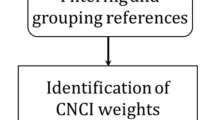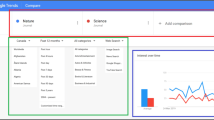Abstract
Nature, Science, and PNAS are the three most prestigious general-science journals, and Nature and Science are among the most influential journals overall, based on the journal Impact Factor (IF). In this paper we perform automatic classification of ~ 50,000 articles in these journals (published in the period 2005–2015) into 14 broad areas, to explore disciplinary profiles of these journals and to determine their field-specific IFs. We find that in all three journals the articles from Bioscience, Astronomy, and Geosciences are over-represented, with other areas being under-represented, some of them severely. Discipline-specific IFs in these journals vary greatly, for example, between 18 and 46 for Nature. We find that the areas that have the highest disciplinary IFs are not the ones that contribute the most articles. We also find that publishing articles in these three journals brings the prestige for articles in all areas, but at different levels, the least being for Astronomy. Comparing field-specific IFs of Nature, Science and PNAS to other top journals in six largest areas (Bioscience, Medicine, Geosciences, Physics, Astronomy, and Chemistry) these three journals are always among the top seven journals, with Nature being at the very top for all fields except in Medicine.











Similar content being viewed by others
References
Ackerson, L. G., & Chapman, K. (2003). Identifying the role of multidisciplinary journals in scientific research. College & Research Libraries,64(6), 468–478.
Archambault, É., & Larivière, V. (2009). History of the journal impact factor: Contingencies and consequences. Scientometrics,79(3), 635–649.
Bar-Ilan, J. (2010). Rankings of Information and Library Science journals by JIF and by h-type indices. Journal of Informetrics,4(2), 141–147.
Bar-Ilan, J. (2012). Journal report card. Scientometrics,92(2), 249–260.
Bornmann, L., Werner, M., Gasparyan, A. Y., & Kitas, G. D. (2012). Diversity, value and limitations of the journal impact factor and alternative metrics. Rheumatology International,32(7), 1861–1867.
Calcagno, V., Demoinet, E., Gollner, K., Guidi, L., Ruths, D., & de Mazancourt, C. (2012). Flows of research manuscripts among scientific journals reveal hidden submission patterns. Science,338(6110), 1065–1069.
Csiszar, A. (2018). The scientific journal: Authorship and the politics of knowledge in the nineteenth century. Chicago: The University of Chicago Press.
De Rijcke, S., Wouters, P., Rushforth, A., Franssen, T., & Hammarfelt, B. (2016). Evaluation practices and effects of indicator use—A literature review. Research Evaluation,25(2), 161–169.
Ding, J., Ahlgren, P., Yang, L., & Yue, T. (2018). Disciplinary structures in Nature, Science and PNAS: Journal and country levels. Scientometrics,116(3), 1817–1852.
DORA. (2012). San Francisco declaration of research assessment. Retrieved November 21, 2019 from http://www.ascb.org/files/SFDeclarationFINAL.pdf.
Fang, H. (2015). Classifying research articles in multidisciplinary science journals into subject categories. Knowledge Organization,42(3), 139–153.
Fortunato, S., Bergstrom, C. T., Börner, K., Evans, J. A., Helbing, D., Milojević, S., et al. (2018). Science of science. Science. https://doi.org/10.1126/science.aao0185.
Garfield, E. (1972). Citation analysis as a tool in journal evaluation. Science,178, 471–479.
Garfield, E. (2006). The history and meaning of the journal impact factor. JAMA,295(1), 90–93.
Glänzel, W., & Schubert, A. (2003). A new classification scheme of science fields and subfields designed for scientometric evaluation purposes. Scientometrics,56(3), 357–367.
Glänzel, W., Schubert, A., & Czerwon, H. J. (1999a). An item-by-item subject classification of papers published in multidisciplinary and general journals using reference analysis. Scientometrics,44(3), 427–439.
Glänzel, W., Schubert, A., Schoepflin, U., & Czerwon, H. J. (1999b). An item-by-item subject classification of papers published in journals covered by the SSCI database using reference analysis. Scientometrics,46(3), 431–441.
Gordon, M. D. (1984). How authors select journals: A test of the reward maximization model of submission behavior. Social Studies of Science,14, 27–43.
Haustein, S. (2012). Multidimensional journal evaluation: Analyzing scientific periodicals beyond the impact factor. Berlin: De Gruyter Saur.
Hicks, D. M., & Katz, J. S. (1996). Where is science going? Science, Technology and Human Values,21(4), 379–406.
Ioannidis, J. P. (2006). Concentration of the most-cited papers in the scientific literature: Analysis of journal ecosystems. PLoS ONE,1(1), e5.
Javitz, H., Grimes, T., Hill, D., Rapoport, A., Bell, R., Fecso, R., & Lehming, R. (2010). U.S. Academic Scientific Publishing. Working paper SRS 11-201. Arlington, VA: National Science Foundation, Division of Science Resources Statistics.
Johns, A. (1998). The nature of the book: Print and knowledge in the making. Chicago: The University of Chicago Press.
Kaneiwa, K., Adachi, J., Aoki, M., Masuda, T., Midorikawa, A., Tanimura, A., et al. (1988). A comparison between the journals Nature and Science. Scientometrics,13(3–4), 125–133.
Katz, J. S., & Hicks, D. (1995). The classification of interdisciplinary journals: A new approach. Paper presented at the Proceedings of the fifth international conference of the international society for scientometrics and informetrics, Rosary College, River Forest, IL.
Larivière, V., Kiermer, V., MacCallum, C., McNutt, M., Patterson, M., Pulverer, B., et al. (2016). A simple proposal for the publication of journal citation distributions. Biorxiv. https://doi.org/10.1101/062109.
López-Illescas, C., Noyons, E. C., Visser, M. S., De Moya-Anegón, F., & Moed, H. F. (2009). Expansion of scientific journal categories using reference analysis: How can it be done and does it make a difference? Scientometrics,79(3), 473–490.
Meadows, A. J. (1998). Communicating research. San Diego: Academic Press.
Milojević, S., Radicchi, F., & Bar-Ilan, J. (2017). Citation success index—An intuitive pair-wise journal comparison metric. Journal of Informetrics,11(1), 223–231.
Milojević, S. (2020). Practical method to reclassify Web of Science articles into unique subject categories and broad disciplines. Quantitative Science Studies. https://doi.org/10.1162/qss_a_00014.
Moed, H. F., & Van Leeuwen, T. N. (1996). Impact factors can mislead. Nature, 381(6579), 186.
Palmer, C. L. (1996). Information work at the boundaries of science: Linking library services to research practices. Library Trends,45(2), 165–191.
Price, D. J. de Solla. (1961). Science since Babylon. New Haven: Yale University Press.
Price, D. J. de Solla. (1963). Little science, big science. New York: Columbia University Press.
Price, D. J. de Solla. (1974). Society’s needs in scientific and technical information. Ciência da Informação,3(2), 97–103.
Radicchi, F., Fortunato, S., & Castellano, C. (2008). Universality of citation distributions: Toward an objective measure of scientific impact. PNAS,105, 17268–17272.
Ravetz, J. R. (1971). Scientific knowledge and its social problems. New York: Oxford University Press.
Reedijk, J., & Moed, H. F. (2008). Is the impact of journal impact factors decreasing? Journal of Documentation,64(2), 183–192.
Rousseau, R. (2002). Journal evaluation: Technical and practical issues. Library Trends,50(3), 418–439.
Rousseau, S., & Rousseau, R. (2012). Interactions between journal attributes and authors’ willingness to wait for editorial decisions. Journal of the American Society for Information Science and Technology,63(6), 1213–1225.
Rushforth, A., & De Rijcke, S. (2015). Accounting for impact? The Journal Impact Factor and the making of biomedical research in the Netherlands. Minerva,53(2), 117–139.
Seglen, P. O. (1992). The skewness of science. Journal of the American Society for Information Science,43(9), 628–638.
Seglen, P. O. (1997). Why the impact factor of journals should not be used for evaluating research. BMJ: British Medical Journal,314(7079), 498–502.
Sekara, V., Deville, P., Ahnert, S. E., Barabási, A. L., Sinatra, R., & Lehmann, S. (2018). The chaperone effect in scientific publishing. Proceedings of the National Academy of Sciences,115(50), 12603–12607.
Stringer, M., Sales-Pardo, M., & Amaral, L. A. (2008). Effectiveness of journal ranking schemes as a tool for locating information. PLoS ONE,3(2), e1683.
Thelwall, M. (2012). Journal impact evaluation: A webometric perspective. Scientometrics,92(2), 429–441.
Verma, I. M. (2015). Impact, not impact factor. Proceedings of the National Academy of Sciences (PNAS),112(26), 7875–7876.
Waltman, L., & van Eck, N. J. (2012). A new methodology for constructing a publication-level classification system of science. Journal of the American Society for Information Science and Technology,63(12), 2378–2392.
Ziman, J. (1969). Information, communication, knowledge. Nature,224, 318–324.
Zuckerman, H., & Merton, R. K. (1971). Patterns of evaluation in science: Institutionalisation, structure and functions of the referee system. Minerva,9(1), 66–100.
Acknowledgements
This work uses Web of Science data by Clarivate Analytics provided by the Indiana University Network Science Institute and the Cyberinfrastructure for Network Science Center at Indiana University. This material is based upon work supported by the Air Force Office of Scientific Research under award number FA9550-19-1-0391. I dedicate this paper to the memory of my dear friend and colleague Judit Bar-Ilan. I think she would have been interested in this topic and I wish we had an opportunity to work on it together.
Author information
Authors and Affiliations
Corresponding author
Additional information
This paper is dedicated to the memory of Judit Bar-Ilan (1958–2019), an outstanding scholar and an inimitable friend and colleague.
Rights and permissions
About this article
Cite this article
Milojević, S. Nature, Science, and PNAS: disciplinary profiles and impact. Scientometrics 123, 1301–1315 (2020). https://doi.org/10.1007/s11192-020-03441-5
Received:
Published:
Issue Date:
DOI: https://doi.org/10.1007/s11192-020-03441-5




